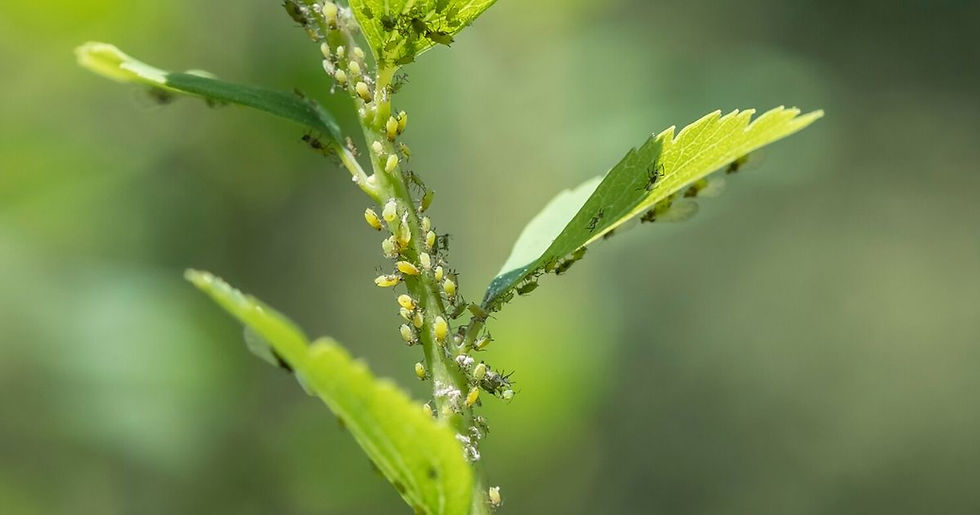Natural Ways to Rid Your Permaculture Garden of Aphids
- Rifke Hill
- Nov 7, 2019
- 3 min read
You’ve spotted them. They’re tiny, they’re multiplying, and they’re sucking the life out of the plants in your eco organic garden.
We’re talking about aphids.
Aphids are fascinating little specimens: ants and aphids have one of the insect world’s most marvelous symbiotic relationships. However, aphids can damage your plants. They live off plant sap, and can severely slow down garden growth, or even bring it to a sad, wilted halt.

Some signs that your garden may be suffering under an aphid infestation:
deformed or stunted leaves, fruit or flowers;
a clear, sticky substance on stems and leaves;
sooty mold growing on plants.
So how can you get rid of these tiny trouble makers using only environmentally friendly methods that don’t clash with your organic gardening ideals?
We’re here to help with a list of simple, natural and effective aphid control methods.
How to get rid of aphids the natural way.
Dislodge them with cold water.
Spraying plants down with a jet of water from your hosepipe usually does a wonderful job of evicting aphids. They’re slow moving and struggle to find their way back onto the plant, so splashing infested plants every day helps to eliminate these pests. If you’re looking for fun yet productive children’s outdoor play ideas, enlist your kids to help with this project… kids love playing with water.

Dust plants with flour.
All purpose white flour blocks up an aphid’s internal system, so toss a generous sprinkling of white flour on plants to help kill them off. Don’t neglect the undersides of leaves and flowers: aphids love hanging out in these sheltered spots.

Apply diatomaceous earth.
Diatomaceous earth is an organic substance that’s made from the fossilized remains of certain aquatic organisms, and it’s effective at killing bugs. Sprinkle it on infected plants to eradicate aphids. Keep your bug eliminating forays friendly to your local ecosystem by refraining from using Diatomaceous Earth when your plants are in bloom: it can kill some pollinators, too.
Use Neem oil.
This organic oil is extracted from a tree native to southern Asia, and it works wonders on aphid infestations. Invest in some and apply it to the soil around infected plants, following the instructions on the bottle.

Control your garden’s ant population.
Ants take care of aphids, so often, the key to getting rid of aphids is keeping the ant population down.
Make a homemade garlic spray.
This garlic spray won’t kill anything, but it does make your plants unpalatable to hungry bugs. Crush a head of garlic and leave it to steep in two cups of hot water for around twelve hours. Remove the garlic head – you can drop it into your compost bin – and pour your garlic “tea” into a spray bottle. Or pour it into two, and get your kids to help you battle bugs with their garlic “water cannons” for some fun and productive outdoor play time.

Here’s how to prevent aphid infestations in the future.
Grow repelling and distracting plants.
Aphids hate the smell of catnip, garlic and chives, so plant these close to your plants. On the other hand, they are highly attracted to mustard, nasturtium, cosmos, dahlias and asters, so sow these in a group far away from your other plants. They can become the local aphid buffet and keep these pests away from your garden beds.
Bring in some natural predators.
Lacewings, ladybugs and predatory wasps feed on aphids. You can order them online and introduce them to your garden to keep the aphid population down.
Defeating aphids the natural way takes patience and persistence. However, if you combine a few of the methods in this list, it’s a battle you’ll win.

Next time you’re gearing up for a gardening expedition, drop by and take a look at our biodegradable peat pots and seedling trays. You won’t feel guilty when you’re sowing seeds in these… knowing that they’re fully biodegradable, eco friendly and a great price. You can order them conveniently online.

Written by Rifke Hill
About the Author
Rifke Hill was raised on the sort of farm your grandparents told tales about – milking cows, gathering eggs, hoeing the soil, and building fires to heat water. She now spends part of her time copywriting online as a freelancer. The rest of it is spent nurturing and teaching her four energetic children, growing vegetables, baking bread, reading voraciously, having coffee with the neighbors, and enjoying the sunny slopes of the smallholding where she lives, in the Garden Route, South Africa.



Comentários